Thursday 7 April 2022: first departure of the Holland Norway Lines ropax cruise ferry ROMANTIKA from Eemshaven (Netherlands) to Kristiansand (Norway).
A few days before the start, we interviewed Bart Cunnen, CEO.

Bart Cunnen, where does the idea to create Holland Norway Lines come from?
The idea started to grow when I worked for Stena Line (1997-2004). Already then, I was thinking about the potential of a ferry route linking The Netherlands with Norway. The big issue was to find a suitable vessel. It required enough cabins, enough deck space for cars and freight, and a certain degree of luxury was essential to attract tourism customers.
The start of the pandemic caused an issue for Arkitech, our company specialised in making ferries and cruise ships more sustainable. It was a company which I started with Patrick America, a childhood friend (and now CFO of Holland Norway Lines). Because the whole cruise industry was halted, we needed to make a move and adapt. Corona had one advantage: we started to see that ferries were becoming available on the market. Our old dream could become reality. Every crisis brings opportunities, and that was exactly what happened. We found ROMANTIKA and signed a contract for a bareboat charter, for at least three years with an option to extend the agreement for another two years.
Who will be your customers?
Our business model is based on three major groups of customers:
- Freight, even if the lane metre capacity on ROMANTIKA is on the low side. But there is a lot of interest.
- Passengers with cars, who go on holiday, from The Netherlands, Belgium, France, Germany to Norway, or vice versa from Norway to Europe. Especially for the inhabitants of Southern Norway this is a much more interesting route (than Oslo). People visiting Norway are much faster in the fjord area via Kristiansand.
- Minicruise passengers, just doing a return crossing (or with two overnights in Kristiansand). All passenger decks have been refurbished just before the pandemic, which means the ‘cruise’ quality of the vessel is high.
Who are the investors?
Patrick America, myself, and groups of investors from different industries: logistics, port builders, warehousing operators etc.
We have been looking for investors who could bring something into the company, not only money. People and experience are of paramount importance in such a start-up.
One of the investors, a terminal builder, will expand our ferry terminal in Eemshaven from less than 3 hectares to 7 hectares.
Our senior management team has tons of experience, such as the director of hospitality, Bernard Lensink, who comes from the hospitality business, the Chief Officer who is a former cruise captain, a terminal director who was the boss of several terminals etc.
How were your plans received in Kristiansand and Groningen?
Port of Kristiansand was very enthusiast, even if it also means extra competition for the existing operators (Fjord Line, Color Line). Now we already have 70,000 booked passengers. I am not so sure they come from the other ferry companies. I believe many of these are new passengers.
We see that many people book a one-way ticket, which means they will use another route on the way back. It brings business to the wider region.
It also fits in the concept of slow travel, where people want to discover at their own pace. People might start their holiday on our ferry, drive to the fjords, and return via Sweden and Germany.
People from Groningen were equally enthusiast but also are very down to earth. They were not suspicious, just realistic. They have a ‘first see, then believe’ attitude.
We hired a lot of people from this province, which helps for the credibility.
As far as I know this is the first real service from Eemshaven to Kristiansand. You do need a lot of money to get started. You need the right ship and the right partners.
ROMANTIKA has been reflagged. Why?
We decided to reflag the vessel to the Dutch flag. We believe that to be successful the flag had either to be Dutch or Norwegian. With this flag, we get more support from the port- and local authorities.
“Norway without flying”, is that an argument which convinces passengers?
You need a well-booked ship before you can say that it is better to sail across than flying. I think you need to sail to at least 50-60% capacity.
Ecology is not only about plane versus ship. Ecology can also be found in the way we operate, like sourcing local food, and working with a local laundry company. We also try to have as many Dutch staff onboard as possible, creating local employment.
We asked specialists to find out how to reduce the fuel consumption, taking care of every single detail which could help. During drydock we installed a shore power system, which was quite a significant investment.
That is the kind of things we do to improve the sustainability of the ship.
Your website says you aim to be the first emission-free ferry in 2027?
This depends on two things.
First, on how fast the service will be successful. Naval architecture company C-Job is one of our co-owners and are already working on plans for a new ship.
Second, when we go for sustainability, we are talking about big investments and eventual subsidies. Norway is more advanced in this run for greener ships. The Dutch are a bit slower. This could mean that a new ship might have to be built in Norway.
A new ship is very ambitious for a new-born company?
It is, but we must be realistic too. The hydrogen for use on large ships like ours is not available yet. It is used on barges and small ferries, but not on a ship of 40-50,000 GT that must sail 18 hours. But we shall do what is possible, and as sustainable as possible.
Thank you, congratulations, and good luck with Holland Norway Lines!



